高中英语必修四 教案
人教版高中英语必修四 Unit 4 Body Language 教案

高中英语教学设计教学重难点Teaching FocusMake the students understand that body language has cultural diversity and there is no division of good or bad for the diversity.ChallengeMake sure that the students will have the awareness to use and try to understand others’ body language when they communicate with others in the future.教学准备A. A projectorB. computer for multimedia teaching教学方法Teaching methodsA. Asking-and-answering between the teacher and the studentsB.. Interaction among individuals, pair-work and group-workC. Task-based teachingD. Teacher’s demonstration and interpretationE. Role-playingF. Students’ discovery教学过程设计活动内容Step 2介绍身势语的重要性A.Telling Students the Story of Tai Lihua and Making Them Know theImportance of Body Language in Her Life ( 3 min )1.Present the pictures of Thousands of Hands Kwan-yin , and ask the students whether they know thegirl who dances in the front.2. Tell the students tell life story of Tai Lihua and ask them the question “What are the key factors forher success in her life?”The life story of Tai LihuaHer name is Tai Lihua(邰丽华). She is called a Fairy of Peach blossom(桃花仙子) by people. You knowshe is a deaf girl, but she is a wise, diligent, charming and energetic girl. She studied very hard and got two degrees of bachelors in university. She was famous as an artist for her wonderful performance. She is deafand dumb. But how did she get that great achievement and became a successful person? She loves life very much. We should learn from her spirit. Besides her hard working, body language plays a very importantpart in her life. We are all healthy people, sometimes we can use body language to express ourselves. Sowe should pay more attention to learning body languages.B.Showing the Students the Science Report of the Importance Body Language,Making Them Know That Body Language Is As Important For Us As ForDisabled Person Like Tai Lihua. ( 1 min )Some psychologist believe that we communicate 65% of our ideas and feelings without words! The shape of our bodies and faces, the movements and gestures we make, the clothes we wear, how near we stand to each other and whether we touch each other…all these communicate. we must study all these types of information if we want to truly understand what other people are saying.Step 3介绍不同类型的身势语() ( step 3 will use around 5 min )A. Showing the Students The Four Types of Body LanguageGestureFacial expressionEye contactPostureB. Guessing The Meaning of GesturesThe teacher show the students a series of pictures of a man using different gestures, and the students are supposed to say their meaning.C.Acting Out By GesturesThe teacher show the students some English words and ask them to act them out together by using gestures.Victory!Ok !Be quiet!You!D. Chasing the Right WordThe teacher will show the students a series of pictures describing different facial expressions and askthe students to choose the right word for each.E. Matching the Right Interpretation Of the EyesThe teacher will present students several pictures of eyes and ask the students to match the right interpretation.Threatening No. sixThank you ! Congratulations!Facial expressionanger fear joy sorrow contempt轻视surprise disgust 厌恶What do you see in the eyes below?That’s a problem. I need to thinkfor while.a whileIt’s you! Let’s have a duel!That’s horrible! I’m terrified!The next minute,you’re a dead body!I’m in great sorrownes s…I won’t give up! We’ll soon winback!F. Guessing The Meaning of Postures in Real ContextI’m listening carefully!What do we know from their posture?Nice to meet you!This woman is listening to your ideas…You meet this man for the first time…Give me a little time!I’m still thinking!You are asking this womanTo finish her work as soon as possible…You are asking this woman ”Have you got any good idea?” …I give up!OK!You are asking help from this woman…You are saying “Will you give up!”…G. Matching the Right Meaning of the Given Posturesnervous Bite your nails and fondle hair agreement Nod the head up and downBe not interested Look away or yawn.Do not believe Roll your eyes and turn your head away. angry Frown and turn your back to sb disagreement Shake the headStep 4给身势语下定义A.Finishing the First Question of Warming-up Part ( 3 min )The teacher will ask the students to discuss the question with your partner and try to find what the people in the pictures are communicating.B.Giving Definition To Body Language ( 2 min )The teacher will guide the students to give a general definition to body language.Body languageis a form of non-verbal communication.uses movements or positions of our body to show other people what we are thinking or feeling.mainly includes gesture, facial expression, eye contact, posture four forms.Step 5练习运用身势语A.Acting Out the Following words ( 4 min )This exercise is based on the second question of warming-up part. Two students will be chose to the frontof the class, and each of them will choose five words to act. After their action, other students will try to guess which word they have acted.•Hello!•Goodbye!•Go away!•Expensive!•I’m surprised!•I’m tired•I’m confused!•Good luck•I’m delighted!•I’m upset!•I’m sad!•I forgot!•You are great!•I’m curious!•I ate too much!•Come here!B.Acting Out the Dialogue on Page 67 ( 10 min )The student will work in groups of two to finish the speaking task of this unit on page 67. They are required to use appropriate body language as they are making dialogues. After their pairwork, volunteers will make their dialogue before the whole class.Step 6介绍身势语的文化多样性A.Showing the Cultural Difference in Body Language With Examples ( 2 min )America OKJapan moneyFrance zeroBrazilGermanyrudeB . Presenting the Students the Major Greeting Customs in the World ( 2 min )Person and country Suitable greeting A man from ColumbiaTo a man: same as for a womanTo a woman: touches her shoulder and kissesher on the cheekA woman from BritainTo a man: not to close, shake hands To a woman: shake hands, will get closeA man from JapanTo a man: bowsTo a woman: bowsA man from CanadaTo a man: shake handsTo a woman: shake hands or kisses on both cheeks if knownA woman from FranceTo a man: shake hands, kisses twice on the cheekTo a woman: same to someone she knowsA man from the Middle East or some Muslim countriesTo a man:comes close, shakes handsTo a woman:nodsC. Discussion On the Question That If There is a Division of Good or Bad of the Different Meaning of The Same Body Language Under Different Culture.The students will have 3 minutes for discussion and after that some of them will represent their group to share their idea with the whole class.Step Role Play ( 8 min )USA Nigeria rude Germany Japanone“great”or “good job”。
高一英语外研版必修4module4教案
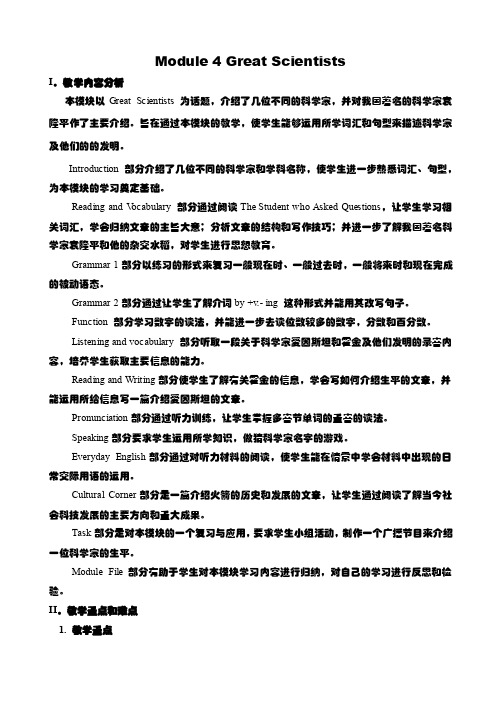
Module 4 Great ScientistsI.教学内容分析本模块以Great Scientists 为话题,介绍了几位不同的科学家,并对我国著名的科学家袁隆平作了主要介绍。
旨在通过本模块的教学,使学生能够运用所学词汇和句型来描述科学家及他们的的发明。
Introduction 部分介绍了几位不同的科学家和学科名称,使学生进一步熟悉词汇、句型,为本模块的学习奠定基础。
Reading and V ocabulary 部分通过阅读The Student who Asked Questions,让学生学习相关词汇,学会归纳文章的主旨大意;分析文章的结构和写作技巧;并进一步了解我国著名科学家袁隆平和他的杂交水稻,对学生进行思想教育。
Grammar 1部分以练习的形式来复习一般现在时、一般过去时,一般将来时和现在完成的被动语态。
Grammar 2部分通过让学生了解介词by +v.- ing 这种形式并能用其改写句子。
Function 部分学习数字的读法,并能进一步去读位数较多的数字,分数和百分数。
Listening and vocabulary 部分听取一段关于科学家爱因斯坦和霍金及他们发明的录音内容,培养学生获取主要信息的能力。
Reading and Writing部分使学生了解有关霍金的信息,学会写如何介绍生平的文章,并能运用所给信息写一篇介绍爱因斯坦的文章。
Pronunciation部分通过听力训练,让学生掌握多音节单词的重音的读法。
Speaking部分要求学生运用所学知识,做猜科学家名字的游戏。
Everyday English部分通过对听力材料的阅读,使学生能在情景中学会材料中出现的日常交际用语的运用。
Cultural Corner部分是一篇介绍火箭的历史和发展的文章,让学生通过阅读了解当今社会科技发展的主要方向和重大成果。
Task部分是对本模块的一个复习与应用,要求学生小组活动,制作一个广播节目来介绍一位科学家的生平。
高中英语必修四《Bodylanguage》教案设计
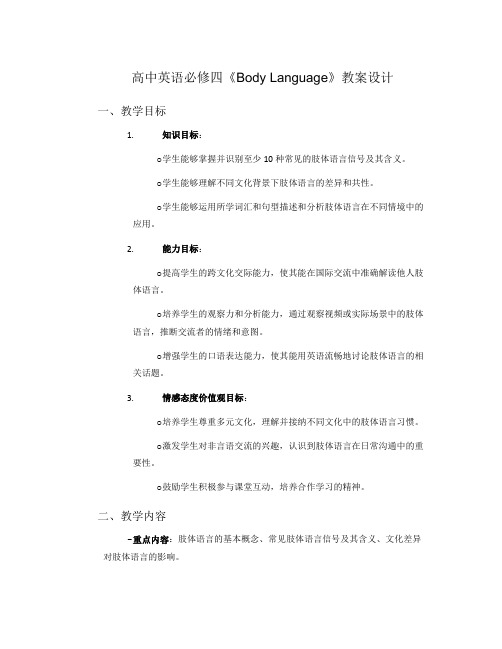
高中英语必修四《Body Language》教案设计一、教学目标1.知识目标:o学生能够掌握并识别至少10种常见的肢体语言信号及其含义。
o学生能够理解不同文化背景下肢体语言的差异和共性。
o学生能够运用所学词汇和句型描述和分析肢体语言在不同情境中的应用。
2.能力目标:o提高学生的跨文化交际能力,使其能在国际交流中准确解读他人肢体语言。
o培养学生的观察力和分析能力,通过观察视频或实际场景中的肢体语言,推断交流者的情绪和意图。
o增强学生的口语表达能力,使其能用英语流畅地讨论肢体语言的相关话题。
3.情感态度价值观目标:o培养学生尊重多元文化,理解并接纳不同文化中的肢体语言习惯。
o激发学生对非言语交流的兴趣,认识到肢体语言在日常沟通中的重要性。
o鼓励学生积极参与课堂互动,培养合作学习的精神。
二、教学内容-重点内容:肢体语言的基本概念、常见肢体语言信号及其含义、文化差异对肢体语言的影响。
-难点内容:如何在具体情境中准确识别并解读复杂的肢体语言信号,以及如何在跨文化交流中有效运用肢体语言。
三、教学方法-讲授法:介绍肢体语言的基本概念和理论知识。
-讨论法:分组讨论不同文化背景下肢体语言的差异,分享个人经验。
-案例分析法:通过观看视频片段,分析具体情境中的肢体语言。
-多媒体教学:利用、视频和音频资源,丰富教学内容,提高学生的学习兴趣。
四、教学资源-教材:《高中英语必修四》-教具:多媒体投影仪、电脑-多媒体资源:肢体语言相关视频、课件、音频材料-实验器材:无五、教学过程六、课堂管理1.小组讨论:每组分配明确的任务,确保每位学生都有参与机会。
设定时间限制,避免讨论偏离主题。
2.维持课堂纪律:通过设定课堂规则,如举手发言、尊重他人意见等,维持良好的课堂秩序。
3.激励学生:对积极参与课堂活动和表现突出的学生给予表扬,激发学生的积极性和参与热情。
七、评价与反馈1.课堂小测验:通过选择题或填空题的形式,测试学生对肢体语言基本知识的掌握情况。
高中英语人教版必修四单元教案:Unit4BodyLanguage
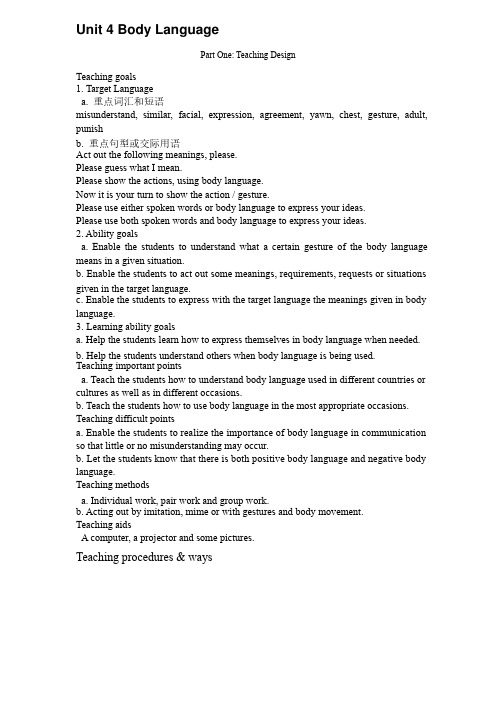
Unit 4 Body LanguagePart One: Teaching DesignTeaching goals1. Target Languagea. 重点词汇和短语重点词汇和短语misunderstand, similar, facial, expression, agreement, yawn, chest, gesture, adult, punishb. 重点句型或交际用语重点句型或交际用语Act out the following meanings, please.Please guess what I mean.Please show the actions, using body language.Now it is your turn to show the action / gesture.Please use either spoken words or body language to express your ideas.Please use both spoken words and body language to express your ideas.2. Ability goalsa. Enable the students to understand what a certain gesture of the body language means in a given situation.b. Enable the students to act out some meanings, requirements, requests or situations given in the target language.c. Enable the students to express with the target language the meanings given in body language.3. Learning ability goalsa. Help the students learn how to express themselves in body language when needed.b. Help the students understand others when body language is being used.Teaching important pointsa. Teach the students how to understand body language used in different countries or cultures as well as in different occasions.b. Teach the students how to use body language in the most appropriate occasions. Teaching difficult pointsa. Enable the students to realize the importance of body language in communication so that little or no misunderstanding may occur.b. Let the students know that there is both positive body language and negative body language.Teaching methodsa. Individual work, pair work and group work.b. Acting out by imitation, mime or with gestures and body movement.Teaching aidsA computer, a projector and some pictures.Teaching procedures & waysThe first period reading(COMMUNICATION: NO PROBLEM?)AimsTo help students develop their reading ability.To help students learn about body language.ProceduresI. Warming upWarming up by actingLook at the list of interpretation on the right side of the chart. Perform the action or the nonverbal behaviour on the left side.Examples Of Body LanguageWarming up by defining—What is body language?II. Pre-reading1. Looking and sayingLook at the man in the picture below. What does he say to you by his body language?Basically, how the ...... do I know? Or, I don’t know nothin! The shoulders are hunched and the hands are open signifying a big question mark.2. Talking and sharingBody language is the quiet, secret and most powerful language of all!According to experts, our non-verbal language communicates about 50% of what we really mean (voice tonality contributes 38%) while words themselves contribute a mere 7%.Our bodies send out messages constantly and often we don't recognize that we're communicating a lot more than we realize.Our understanding and use of non-verbal cues in facial expression are familiar to us nearly from birthIII. Reading1. Reading aloud to the recordingNow please listen and read aloud to the recording of the text COMMUNICATION: NO PROBLEM?. Pay attention to the pronunciation of each word and the pauses within each sentence. I will play the tape twice and you shall read aloud twice, too.2. Reading and underliningNext you are to read and underline all the useful expressions or collocations in the passage. Copy them to your notebook after class as homework.3. Reading to identify the topic sentence of each paragraphNext you are to skim the text to identify the topic sentence of each paragraph.4. Reading and transferring informationRead the text again to complete the table. Where is he/ she from? What does he/ she do when he/ she meet someone at the airport for the first time?Name Country Action MeaningMr GarciaJulia SmithAhmed AzizMadame Coulon5. Reading and understanding difficult sentencesAs you have read the text times, you can surely tell which sentences are difficult to understand. Now put your questions concerning the difficult points to me the teacher.6. Reading and translatingNow it’s time to translate the text into Chinese, sentence by sentence. Who will be the first to d o it?IV. Closing downClosing down by doing exercisesTo end the lesson you are to do the comprehending exercises No. 1 and 2 on page 26 and 27.Closing down by checkingC heck some of the following basic non-verbal cues and you'll recognize that you already speak and translate much of the language.“I’m surprised!” I’m shocked!” “I’m sad!”The second period Learning about Language(The ~ing form as the Attribute & Adverbial)I. Warming upWarming up by discovering useful words and expressionsTurn to page 27 and do exercises No. 1, 2 ,3 and 4 first. Check your answers against your classmates’.II. Learning about grammar1. Reading and thinkingTurn to page 25 and read with me the text of COMMUNICATION: NO PROBLEM? As you read along, pay attention to the uses of The ~ing form as the Attribute & Adverbial. (They are visitors coming from several countries. 作定语;Four people enter looking around in a curious way. 作状语;作状语; This is an exciting experience for you. 作定语; You stand watching and listening. 作状语;……)2. Doing exercises No. 1 and 2 on page 29Turn to page 29. Do exercises No. 1 and 2。
高中英语 Unit 4《Body Language》教案(7) 新人教版必修4

Unit 4 Body language 教案示例(1)教学目的和要求(Teaching aims and demands)教学建议(Suggested teaching notes)一、教学内容分析本单元的中心话题是“身势语”。
身势语是非语言交际手段中非常重要的一个方面,它通过无声的语言表达一个人的内心自世界。
与有声语言一样身势语也是文化的载体,在跨文化交际中起着举足轻重的作用。
了解身势语的不同文化涵义并正确地加以运用,经常会在交际场合起到意想不到的好效果。
教师在教授本单元时,可以提醒学生注意自己和他人在日常交际中的体态、姿势、面目表情等等,正确地理解和运用身势语,以达到良好的交际效果。
“热身”(Warming Up)部分以列表对比的形式引导学生了解有声语言与身势语之间的对应关系,并建议学生把这些动作表演出来,既有趣味性,又有体验实践性。
“读前”(Pre-reading)部分首先引导学生对语言的目的、身势语的含义进行思考,随后引导学生联系自己日常生活的实际,想一想How can you tell if someone is sad even if they do not speak?最后一个问题,启发学生说出身势语在跨文化交际中的作用。
“阅读”(Reading)部分,以机场迎接客人为场景,讲述了几个不同国家的来宾由于文化背景的差异,初次见面时互相问候的方式迥然相异,而造成的一些小误会。
形象地表明了身势语与文化背景的密切关系,以及身势语在人们日常交际中的重要作用。
这部分的写作方式颇有特色,可以让学生在阅读过程中,很自然地以“你”的身份去观察、倾听在机场发生的一切。
“理解”(Comprehending)部分的前五个小题旨在检查学生对阅读篇章细节的理解,第六、七小题旨在引导学生对身势语的文化差异、身势语的意义进行积极的思考,第八小题则要求学生能够运用细节推断出主人公的性别。
“语言学习”(Learning about Language)部分要求学生根据英文释义填写本单元重点词汇,然后用课文中的词语填空和运用派生法变换词性。
(英语教案)高中英语必修四unit2教案
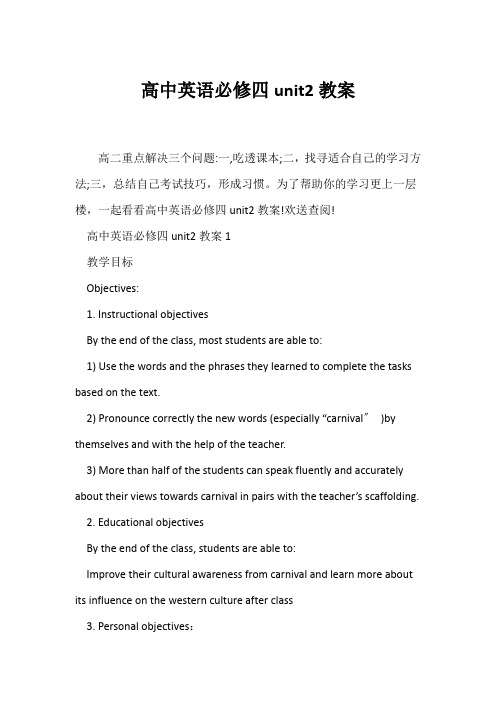
高中英语必修四unit2教案高二重点解决三个问题:一,吃透课本;二,找寻适合自己的学习方法;三,总结自己考试技巧,形成习惯。
为了帮助你的学习更上一层楼,一起看看高中英语必修四unit2教案!欢送查阅!高中英语必修四unit2教案1教学目标Objectives:1. Instructional objectivesBy the end of the class, most students are able to:1) Use the words and the phrases they learned to complete the tasks based on the text.2) Pronounce correctly the new words (especially “carnival〞)by themselves and with the help of the teacher.3) More than half of the students can speak fluently and accurately about their views towards carnival in pairs with the teacher’s scaffolding.2. Educational objectivesBy the end of the class, students are able to:Improve their cultural awareness from carnival and learn more about its influence on the western culture after class3. Personal objectives:1) Be confident of standing on the stage and speak clearly and spontaneously.2) Encourage students to speak in the class with different kind of techniques.教学重难点Focal points:By the end of the class, students are able to:1) Improve the main reading skills through completing reading tasks in pair work and group work.2) Use the table to finish their essay about their favorite film. Difficult points:By the end of the class, students are able to:1) speak fluently and accurately about their favorite films in pairs with the teacher’s scaffolding.2) Write a film review according to the table and the text.教学过程Procedures and time allotmentStage 1 Getting students ready for learningT: Class begins!Ss:…T: Good afternoon, class!Ss:…T: Today, let’s come to Culture Corner. Module 4. Do you know Chinese festivalsSs:…T: First, Work in groups, discuss and make a list of Chinese festivals in English. (1min).Ss:…T: OK, time is up. You know Chinese festivalsSs:…T: very good. For example1.New Year’s Day 元旦节(1月1日)2. Spring Festival 春节(农历正月初一)3. Lantern Festival 元宵节(农历正月15)4. the Qingming Festival 清明节(4月5日)5. Dragon Boat Festival 端午节(农历5月初五6. Double-ninth Day 重阳节(农历9月初九)7.National Day 国庆节(10月1日)T: And festivals brought us much traditional knowledge. So, festival is beautiful. Do you know foreign festivalsSs:...T: In the textbook, there are some festivals with pictures. Do you know the right descriptions about themSs:...T: This festival is at the end of October, when “ghosts〞come out. Ss:...T: This is when Americans remember the hard times when they first arrived in the country.Ss:..T: This is a festival of color, which marks the beginning of spring in India.Ss:...T: This is a Christian festival which comes in the middle of winter Ss:...T: Let’s watch a video. Can you guess what festival it is .T: They are dressed up in special clothes, and they are wear masks. Ss:...T: now, First question is how do people feel on this festival Second is what festival is itSs:...T: Yes, very good. Now, let’s watch a video about Carnival. Ss:...T: what do you remember about carnivalSs:...T: Where did it firstSs:...Stage 2 Pre-readingStep 1. Listen to the tape.T: Lets listen to the following passage to learn more about carnival. Try to find out what places are mentioned in terms of carnival celebrations. Ss:..T:...Step 2. Scan the passage and try to answer the questions.T: What is the meaning of carnivalSs:...T: Originally it meant “with no meat〞but now it symbolizes “life〞. Step 3. Read the passage and match column A with column B.T: OK, now I will give you 1 minute to read it again and then I will ask you someStage 3 While-readingStep 1 Read the passage. Choose the best answers to the two sentences.T: are you finish Let’s look at the questions.first question is Today Carnival has become a celebration of ____. Which one you chooseA. freedomB. harvestC. life itselfD. successSs:...T: YES, very good. Next question is We need to _____ to understandwhat carnival is all about.A. look at the history of AmericaB. go to AmericaC. look at the meeting of two cultures---European and AfricanD. Both A and CSs:...T:....Step 2 check whether the statements are true or false.T: …T: Now, let’s check.With the opening of huge farms and plantations, many Africans went to look for jobs in America., what’s your idea Ss:…T: Do you agreeSs:…T: Excellent, in paragraph 2, this marked the beginning of the slave trade. So the question 1 is False.T: next question 2, The Europeans imported their festivals and later the slaves learned from them and added their traditions.Ss:...T: very good. This answer in paragraph 3.Ss:...T: question 3,The slave trade was abolished and the salves took over the carnival.Ss:...T: the last, With the passing of time, carnival became a festival of the black people only.Ss:…T:Exactly! Superb!Step 3 Skimming for specific informationTask: Answer the questions according to the passage.T: Read the text carefully and answer the questions.Next, we will read the text again to explore how the text organized. 3minutes, Let’s go!T: Now, let’s check your answers. What is carnival todaySs:Carnival today is an international, multicultural experience.T:The second question is Where were the slaves taken fromSs:In AfricaT:....T: Excellent!Stage5 Post-readingDiscussion: Useful questions to make up dialoguesT: there have seven questions, useful questions to make up dialogues. Have you dressed up in special clothes2 What did you wear3 How did you feel4 Did you eat special food5 Did you give or receive gifts6 Did you have a holiday from school7 Did you enjoy yourself with your family or friendsT: I will divide the class into 3 students in a group. 3 minutes, 1, 2, begin!Ss:...T:Time is up. which one do you chooseSs:....T: Yes, so the theme of Frankenstein is about science and humanity. T: OK, next group, do you have other answerSs:...课后习题homeworkDo exercises on Page 37-38.高中英语必修四unit2教案2Period 12 warming up and readingTeaching Aims:1.Enable the students to talk about the qualities needed to be a good reporter and how to conduct a good interview2. Enable the students to learn some reading strategies3. Enable the students to learn the necessary qualities in their future jobImportant Points and difficult pointsLearn about how to be a good reporterTeaching methodsStrategic reading method; Task-based methodTeaching procedures:I. Elaboration (warming up): Help the students to relate their known knowledge to the topic that will be learnedTask 1 :( group discussion) Talk about jobs in China DailyTypes of jobs What it involvesreporterTask2: Predict what is going to be learned by looking at the title of the text. Which type of job will be talked about in the textII. Prediction (pre-reading):Task 3: Predict the main idea of the text by discussing the following questions:1. What are the qualities a good news reporter needs to have (Have group discussion first and then finish Part 1 individually)2. What your first day at school was like How would you feel on your first day at work (Group discussion)III. Skimming, scanning, analyzing (Reading Comprehending)Task 4: Read the text quickly to get a general idea of the text.Task 5: Divide the passage into three sections and match the followingmain ideas to the three sections:How to get an accurate storyHow to protect a story from accusationsHow to become a reporterThe skills neededThe importance of listeningStages in researching a storyHow to check factsHow to deal with accusations of printing liesWork in a teamTask 6 Read quickly to find out the information to fill in the form below Task 7: Tell what is required for a reporter and a photographer patient; imaginative ; well-organized; technically good; polite; concise; thorough; creative; curious; careful; gifted; professionalA reporter A photographerIV. SummarizingTask 8: Write a summary of the textV. AssignmentRead an English newspaper and retell the main idea of one article in it. Period 34 Words ExpressionsTeaching Aims:Get the students to know how to use some words and expressionscorrectly and appropriatelyImportant Points and difficult pointsUse some words and expressions correctly and appropriately Teaching methodsDemonstrating and summarizing; practicingTeaching procedures:1. occupation n.1). Teaching is my occupation. 职业2). Swimming is my occupation. 使…忙碌的事情;消遣occupy v.occupied=busyoccupy oneself in/with sth.employment; occupation; job; profession; vocation; work; trade He is looking around for .: artistHe is out of .She chose teaching as her .She’s a lawyer by .He’s a carpenter by .2. assign v.assignment n.She gladly accepted the assignment. (分派的任务;工作)The English assignment is a book report. (课外作业,功课) 3. on one’s ownof one’s ownfor one’s ownWe should complete the test _________4. experienced adj.be experienced in/at sth/doing sth.Who is experienced in cooking in your home5. The first/last time + 时间状语从句The first time I came here, I was not used to the climate here. Cover n. 封面,掩盖(物) ;v.1). Tom will covered the outbreak of the disease.2). The road was covered with snow.3). She laughed to cover her worry.4). The red army covered about 30 miles a day.5). Is the money enough to cover the cost of a new shirt7. Be eager for sth. (sucess)to do sth.that clauseHe is eager to see his daughter.We are eager that the project should be started earlybe anxious about =be worried about8. Concentrate on sth./doing sth.We should concentrate on our study.Tom is concentrating on fishing.9. of +抽象名词(importance; value; use; help; benefit)of special interest=of no use=The meeting is of great importance.=Each minute is _____ for us.of greatly valuablegreat valuableof great valuefor much value10. acquire; get; gain1). I sat in the front of the bus to ___ _ a good view of the countryside.2). Gradually we _______ experience in how to do the work.3). They _____the victory after a bloody battle.11. have a nose for 嗅觉灵敏She has an ear for music. 有鉴赏能力She has an eye for color and style in clothes. 有眼光12. Meanwhile=in the meanwhile=in the meantime=at the same timeMother went shopping; meanwhile, I cleaned the house 13. trade n. v.1). Japan does lots of trade with the United States.2). He is a shoemaker by trade.3). She trades 3 apples for some bananas.14. Trick1). 窍门,手法2). play a trick(joke)on sb.=make fun of sb. (玩笑,恶作剧)3). He got into the building by a trick (诡计,花招)15. Challenge1).He challenge my view on that matter.2).To finish the job in 2 days was a real challenge.16. Supportn. 1).I need your support.v. 1)为…提供证据,证实2) The old man entered the room supported by his grandson.3). He has always supported the weaker party.4). He has a large family to support.17. Case1).He thought he had solved the problem , but that was not the case.2).Here is a case of being careless.3).We will look into that case.in case of sth. 如果,万一…in that/this case 在那样/这样情况下in no case 决不in case + 从句以防;可能;倘假设Take an umbrella in case it rains.(in case 从句常用一般现在时表将来, 或should+do)17. accuse sb. of sth.=charge sb. with sth.Tom ____ his boss of having broken his word.blamedaccusedchargedscolded18. so as to do sth. 只能在句末= in order to do sth.=so that + 从句= in order that + 从句I got up at five so as to catch the train=19. admitadmit doing /having doneadmit sb. Into/to (the university)Lily finally admitted___ my umbrella by mistake.to taketo have takenhaving takenhave taken20. n. adj.profession professional 具有….特点Finish Ex 3 on Page 29AssignmentFinish Ex1 and Ex 2 on Page 28 and Ex 3 on Page 29 (Discovering useful words and expressions)Finish Ex 2 , Ex3 on Page 63 and Ex4 on Page 64 (Using words and expressions) in Workbook.Period 5 GrammarTeaching Aims:Get the students to use “Inversion〞correctly and appropriately Important Points and difficult pointsUse “Inversion〞correctly and appropriatelyTeaching methodsTask-based method; Demonstrating; discussion; summarizing; practicingTeaching procedures:I. PresentationTask 1: Comprehend the following sentencesOnly then did I begin my work on designing a new bridge.=I began my work on designing a new bridge only then.2. Not only was there a Christmas tree, but also exciting presents under it.=There was not only a Christmas tree, but also exciting presents under it.Inversion: 起强调作用II. Analyzing summarizingTask 2: Find 4 examples of inversion in the reading passage1. Never will Zhou Yang forget his first assignment at the office of China Daily.2. Only when you have seen what he or she does, can you cover a story by yourself.3. Not only am I interested in photography, but I took a course at university.4. Only if you ask many different questions will you acquire all the information you need to knowTask 3: Analyze the sentences above and summarize the rules1. Why can these sentences use inversion2. How are these inverted sentences made※ 否认副词no;not;hardly, little, seldom, never, no sooner…than, no more, not only, only 等开头的句子要局部倒装。
Unit4SPACEEXPLORATION—Discovering高中英语必修教案教学设计
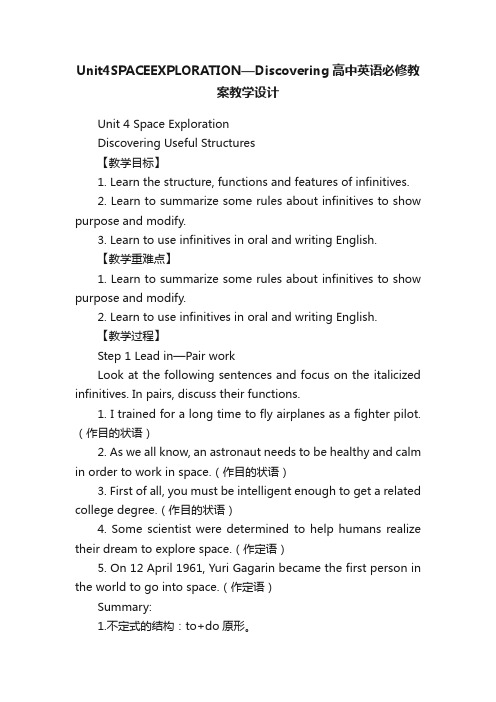
Unit4SPACEEXPLORATION—Discovering高中英语必修教案教学设计Unit 4 Space ExplorationDiscovering Useful Structures【教学目标】1. Learn the structure, functions and features of infinitives.2. Learn to summarize some rules about infinitives to show purpose and modify.3. Learn to use infinitives in oral and writing English.【教学重难点】1. Learn to summarize some rules about infinitives to show purpose and modify.2. Learn to use infinitives in oral and writing English.【教学过程】Step 1 Lead in—Pair workLook at the following sentences and focus on the italicized infinitives. In pairs, discuss their functions.1. I trained for a long time to fly airplanes as a fighter pilot.(作目的状语)2. As we all know, an astronaut needs to be healthy and calm in order to work in space.(作目的状语)3. First of all, you must be intelligent enough to get a related college degree.(作目的状语)4. Some scientist were determined to help humans realize their dream to explore space.(作定语)5. On 12 April 1961, Yuri Gagarin became the first person in the world to go into space.(作定语)Summary:1.不定式的结构:to+do原形。
高中英语人教新课标必修四Unit1 Woman of achievement教案
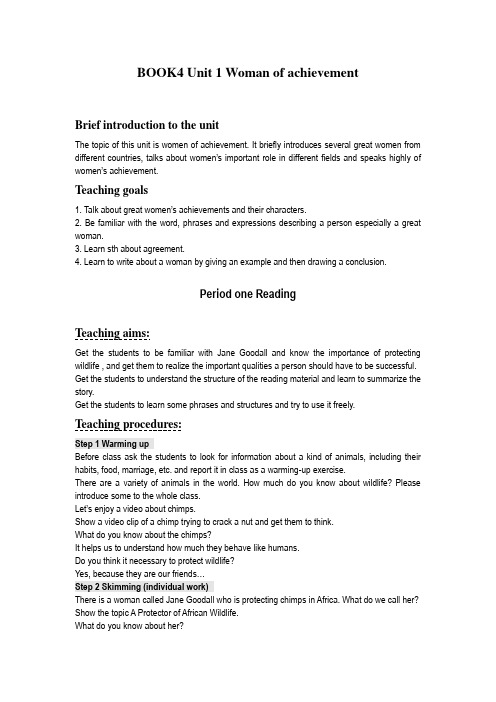
BOOK4 Unit 1 Woman of achievementBrief introduction to the unitThe topic of this unit is women of achievement. It briefly introduces several great women from different countries, talks about women’s important role in different fields and speaks highly o f women’s achievement.Teaching goals1. Talk about great women’s achievements and their characters.2. Be familiar with the word, phrases and expressions describing a person especially a great woman.3. Learn sth about agreement.4. Learn to write about a woman by giving an example and then drawing a conclusion.Period one ReadingTeaching aims:Get the students to be familiar with Jane Goodall and know the importance of protecting wildlife , and get them to realize the important qualities a person should have to be successful. Get the students to understand the structure of the reading material and learn to summarize the story.Get the students to learn some phrases and structures and try to use it freely.Teaching procedures:Step 1 Warming upBefore class ask the students to look for information about a kind of animals, including their habits, food, marriage, etc. and report it in class as a warming-up exercise.There are a variety of animals in the world. How much do you know about wildlife? Please introduce some to the whole class.Let’s enjoy a video about chimps.Show a video clip of a chimp trying to crack a nut and get them to think.What do you know about the chimps?It helps us to understand how much they behave like humans.Do you think it necessary to protect wildlife?Yes, because they are our friends…Step 2 Skimming (individual work)There is a woman called Jane Goodall who is protecting chimps in Africa. What do we call her? Show the topic A Protector of African Wildlife.What do you know about her?Jane Goodall博士于2002年4月16日被任命为联合国和平使者。
- 1、下载文档前请自行甄别文档内容的完整性,平台不提供额外的编辑、内容补充、找答案等附加服务。
- 2、"仅部分预览"的文档,不可在线预览部分如存在完整性等问题,可反馈申请退款(可完整预览的文档不适用该条件!)。
- 3、如文档侵犯您的权益,请联系客服反馈,我们会尽快为您处理(人工客服工作时间:9:00-18:30)。
板
书
设
计
Unit 1 Women of achievement
achievementwelfareconnectionhuman being
campaignorganization
3.Let students read the following and examine the six women using the rules about what makes a great person.
Name
Ambition
Problems
Sacrifices
Joan of Arc
To drive the English out of France
教学
用具
Multimedia & blackboard
教
学
过
程
Step 1 Leading in
Have a free talk with students, ask them the following questions:
1.Do you know any great women in the history
Step 3 Conclusion
What qualities do you think great people have
(clever, brave, determined, confident, unselfish, hard-working......)
Step 4 Homework
1.Learn the useful new words and expressions in this part.
(chimps hunt and eat meat; the way of communication in chimps)
c)How does the author describe the relationship between the chimps.
(we realize that the bond between members of a chimp family is as strong as in a human family)
本科课题
Unit 1 Women of achievement
课型
Reading
共6课时
第2课时
教学目标
知识目标
e the adjectives to describe a great person.
2.Learn the new words and expressions: behave, behaviour, shade, move off, worthwhile, nest, bond, observe, observation, children, outspoken, respect, argue, argument, entertainment, lead...a life, crowd, crowd in,inspire, inspiration.
She has lost her own personal time because of the job.
4.Have students discuss in pairs what they have in common and what makes them great and give them reasons.
Unit 1 Women of achievement
课型
Warming Up
共6课时
第1课时
教学目标
知识目标
1.Get students to learn the new words and expression in this part: achievement, welfare,project, institute,specialist, connection, human being, campaign, organization.
Less time was spent with her husband and family.
Song Qingling
To work for civil rights, democracy and peace.
Her relatives had political opinions completely different from her.
2.Develop students’sense of cooperative learning.
重
点
Improve students’ability of skimming.
难
点
1.Make students understand the reading better.
2.Talk about women of achievement fluently.
After her husband died, she lived alone.
Lin Qiaozhi
To help women and children with their illness and health
Women had great difficulties getting into medical college and getting further training.
2.Develop students’sense of cooperative learning.
重
点
1.Let students learn about great women and their achievements inபைடு நூலகம்different fields in the world.
2.Get students to read the passage and learn different reading skills.
3.Understand the text fully.
能力
1.Develop students’reading ability.
2.Learn to use some reading skills such as predicting, skipping, scanning.
情感
1.Enable students to learn from great women, and develop their moral qualities.
d)About the chimps, what does Jane Goodall call on people to do
(wild animals should be left in the wild and not used for entertainment or advertisement, and set up special places where they can live safely)
2.Let students learn about great women and their achievements in different fields in the word.
能力目标
1.Develop students’reading ability and let them learn different reading skills.
学
过
程
教
学
过
程
Step 2 Warming Up
1.Show some pictures of women for students to guess who they are, and then talk about them.
2.Let students skim the brief introduction of the six women.
方
法
1.Task based method
2.Individual, pair or group work
教学
用具
Multimedia & blackboard
教
学
过
程
Step 1 Leading in
1.Review the achievement of Jane Goodall.
2.Why do you think Jane Goodall went to Africa to study chimps rather than to universityDo you think she was rightGive your reason.
She never got married or had a family of her own.
Jane Doodall
To work with animals in the wild
She lived a hard life in the wild.
She gave up the comforts of life to study the chimps.
Women were not allowed to fight like a man.
She lost her life.
Elizabeth Fry
To help improve prison conditions.
She was criticized for neglecting her family and enjoying fame.
(Madame Curie, Elizabeth, Song Qingling.....)
2.And why do you think they are great women
